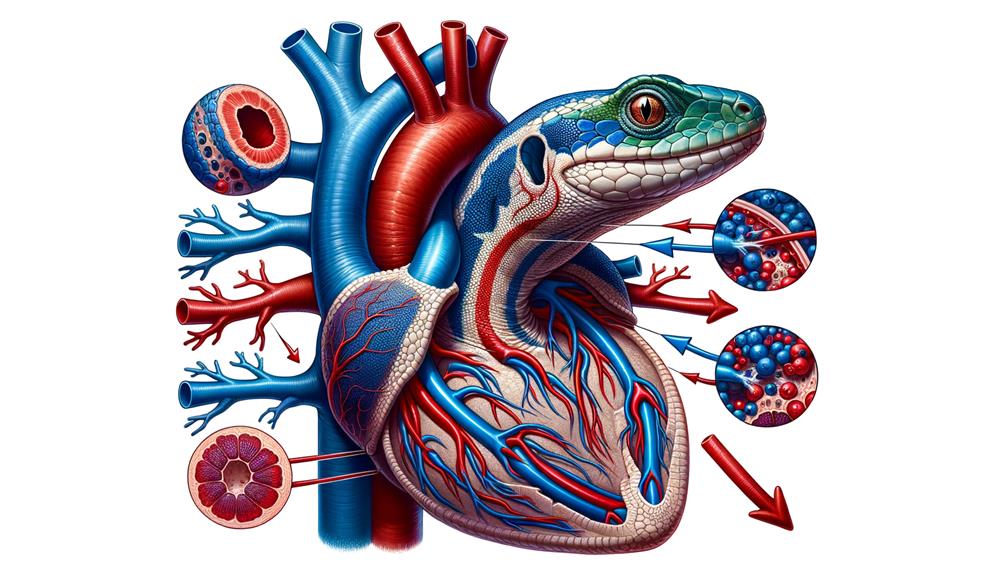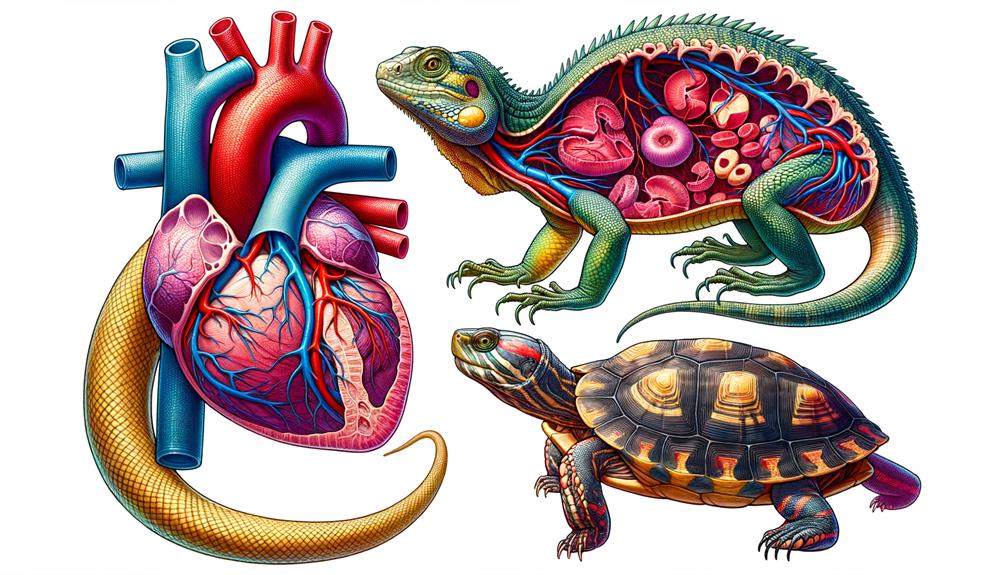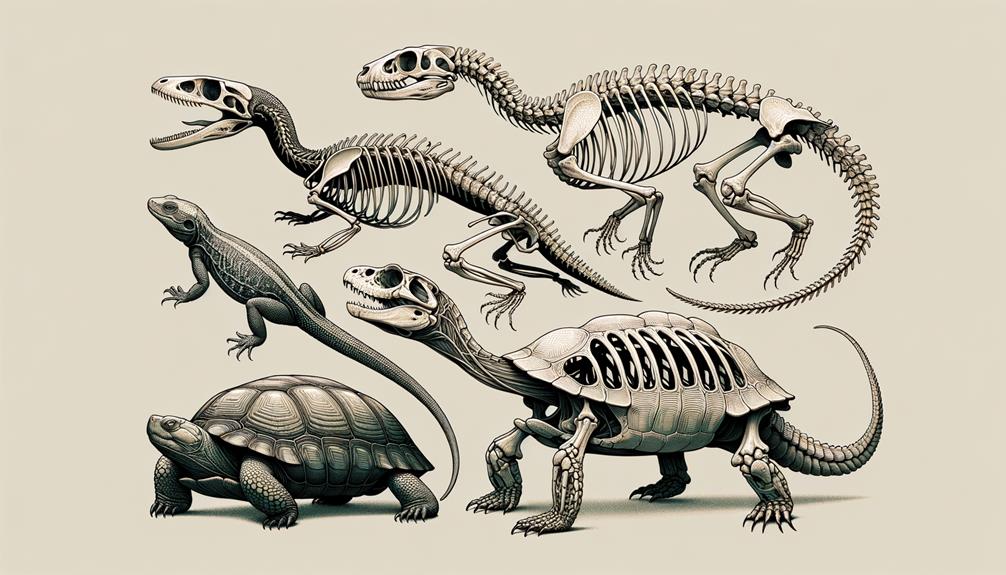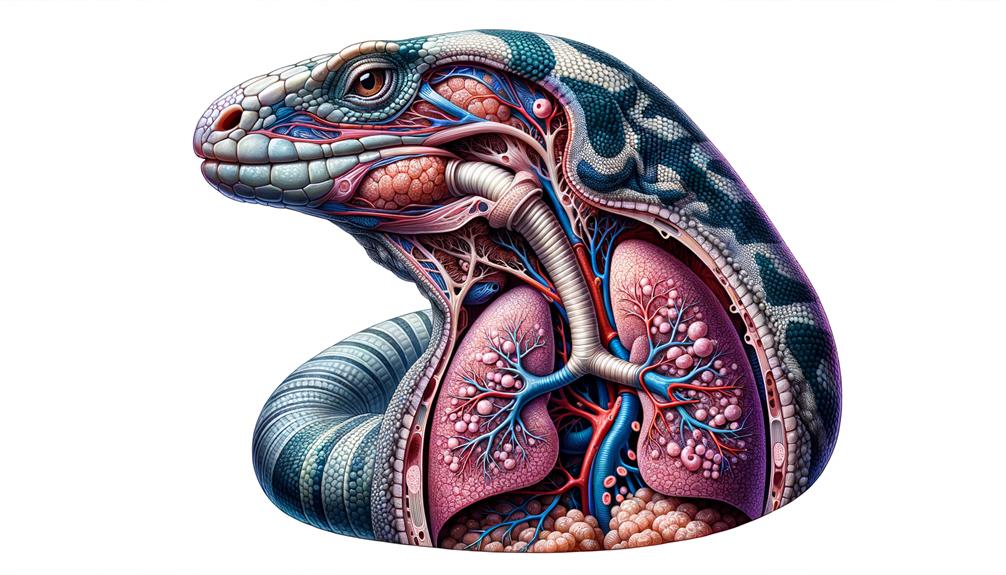I find the adaptations of the reptilian cardiovascular system fascinating. Most reptiles have a three-chambered heart, with two atria and one ventricle, featuring muscular ridges that partially separate blood flow, allowing efficient oxygenation despite some mixing. Crocodilians stand out with a four-chambered heart, similar to birds and mammals, along with the Foramen of Panizza, which enables intricate blood flow control. These differences reflect their evolutionary lineage and diverse living environments. Let's examine how these systems enable reptiles to thrive in various habitats.
Key Takeaways
the content
Reptilian Heart Structure
Reptiles showcase a remarkable diversity in their cardiovascular anatomy. Most species have a three-chambered heart consisting of two atria and a single ventricle divided into three distinct cavities. The right atrium receives deoxygenated blood from the body, while the left atrium accepts oxygenated blood from the lungs. These atria then channel blood into a common ventricle, which is subdivided into three parts: the cavum venosum, cavum arteriosum, and cavum pulmonale.
Muscular ridges within the ventricle partially separate these cavities, ensuring some degree of blood separation. The cavum venosum primarily deals with systemic blood, the cavum arteriosum with oxygenated blood, and the cavum pulmonale with the pulmonary circuit. This unique structure allows reptiles to regulate blood flow according to their activity levels and oxygen needs.
Interestingly, crocodilians are an exception, possessing a four-chambered heart with two atria and two ventricles, similar to birds and mammals. Their hearts feature two aortic arches and the foramen of Panizza, enabling sophisticated control over blood flow. This evolutionary adaptation highlights the diverse ways reptiles have developed to thrive in various environments.
Blood Flow Mechanisms

Understanding the intricacies of reptilian heart structure provides a foundation for appreciating the sophisticated blood flow mechanisms that enable these creatures to maintain efficient circulation in diverse environments. Unlike mammals, reptiles have a range of heart structures, with most having a three-chambered heart consisting of two atria and one partially divided ventricle. This unique structure allows some mixing of oxygenated and deoxygenated blood, yet still supports their distinct lifestyle.
The reptilian circulatory system has adapted remarkably:
The sinus venosus collects deoxygenated blood from the body, directing it into the right atrium. Pulmonary arteries and veins transport blood between the heart and lungs, ensuring oxygenation. Double circulation, involving systemic and pulmonary circuits, maximizes oxygen delivery. Arterioles and venules facilitate the changeover between arteries, veins, and capillary networks. Crocodilian hearts feature a complete septum dividing the ventricles, mimicking the efficiency seen in mammals.
These features demonstrate the evolutionary innovations in reptilian blood flow mechanisms, allowing them to thrive in various habitats. By maintaining a balance between oxygenated and deoxygenated blood flow, reptiles achieve metabolic efficiency vital for their survival.
Oxygen Regulation

Reptiles have evolved complex mechanisms to regulate oxygen intake and distribution, allowing them to survive in environments with varying oxygen levels. A key factor in this adaptation is the unique structure of their hearts. Most reptiles have a three-chambered heart, consisting of two atria and one ventricle. The left atrium receives oxygen-rich blood from the pulmonary veins, while the right atrium collects oxygen-poor blood from systemic circulation. Although the ventricle is not fully separated, it still enables efficient oxygen delivery.
Crocodilians, however, possess a four-chambered heart, similar to that of mammals. This adaptation significantly enhances their ability to oxygenate blood and transport it efficiently. Oxygen-poor blood is pumped from the right ventricle to the lungs via the pulmonary artery, where it becomes oxygen-rich, and then returns to the left atrium through the pulmonary veins, facilitating effective pulmonary circulation. The oxygen-rich blood is then distributed to the body through systemic circulation.
The varying complexity of reptilian lungs, ranging from simple sacs in snakes to more branched systems in lizards, complements these cardiovascular adaptations. When combined with a slower metabolic rate, these features enable reptiles to thrive despite their relatively inefficient respiratory and circulatory systems.
Ph Balance Adaptations

Examining reptiles' pH balance adaptations, I find their ability to regulate blood acid-base balance through specialized respiratory and metabolic mechanisms fascinating. Their kidneys and lungs have efficient buffering systems, including ion-exchange processes, which enable them to maintain homeostasis even under fluctuating conditions. The unique structure of their three-chambered heart also plays a crucial role in buffering blood pH by allowing controlled venous-arterial mixing.
Blood Acid-Base Regulation
Reptiles have developed remarkable physiological adaptations to maintain acid-base homeostasis in their blood, even in conditions that would disrupt pH balance in other vertebrates. The reptile heart, specifically the sinus venosus, plays a crucial role in this process by regulating blood flow and pressure, ensuring efficient mixing of oxygen-rich blood from the lungs with deoxygenated blood.
To maintain stable blood pH, reptiles employ several strategies. They adjust their breathing patterns to control carbon dioxide expulsion, a process known as selective ventilation. They also modify the affinity of hemoglobin for oxygen to manage oxygen delivery and carbon dioxide pickup. Additionally, reptiles prioritize blood flow to regions of the lungs with the highest efficiency for gas exchange and possess nucleated red blood cells, which enhance oxygen transport and buffering capacity. Furthermore, they maintain higher bicarbonate levels, which act as a chemical buffer to neutralize acids.
These adaptations have enabled reptiles to thrive in diverse environments, from deserts to oceans. By maintaining stable blood pH, reptiles can sustain their metabolic functions, even during periods of environmental stress or intense physical activity.
Buffering Mechanism Efficiency
Reptiles have developed intricate buffering mechanisms to regulate their blood pH levels, ensuring metabolic stability in the face of fluctuating environmental conditions. Unlike mammals, they can withstand wider fluctuations in blood pH levels due to specialized enzymes and buffers that meticulously manage acid-base balance. This remarkable ability is crucial for their survival in diverse habitats, ranging from arid deserts to humid rainforests.
The reptilian circulatory system, featuring a three-chambered heart, plays a vital role in maintaining pH homeostasis. This unique structure allows for a partial separation of oxygenated and deoxygenated blood, facilitating efficient gas exchange. By modulating carbon dioxide and oxygen levels, reptiles can stabilize their blood pH even during periods of environmental stress.
Scientists have long been fascinated by reptiles' ability to tolerate temporary blood acidosis or alkalosis, conditions that would be detrimental to mammals. This adaptability is made possible by their efficient buffering systems, which quickly neutralize pH imbalances. For instance, when carbon dioxide levels rise, buffers in the blood swiftly counteract the potential acidosis, ensuring stable conditions for cellular function.
Comparative Anatomy

When I examine reptile hearts, I notice significant variations in their structure, particularly between the three-chambered hearts of most reptiles and the four-chambered hearts of crocodilians. These structural differences directly influence blood flow mechanisms, affecting how efficiently oxygen is transported throughout the body. The evolution of these adaptations reflects the unique metabolic demands and environmental challenges faced by different reptilian species throughout history.
Heart Structure Variations
The diversity of reptilian heart structures is a fascinating example of evolutionary adaptation. From the three-chambered hearts of snakes, lizards, and turtles to the unique four-chambered hearts of crocodilians, each species has developed a unique cardiovascular system tailored to its ecological needs and evolutionary history.
Non-crocodilian reptiles, such as snakes and monitor lizards, have a three-chambered heart with two atria and one ventricle. The ventricular septum is incomplete in these species, allowing for some mixing of oxygenated and deoxygenated blood. This anatomical feature is crucial for their survival in diverse environments. In contrast, crocodilians have a fully developed ventricular septum, effectively creating two ventricles, which ensures a complete separation of blood flow and enhances efficiency.
Some key points to consider include:
- The degree of ventricular septation varies across species, from partial in snake hearts to complete in crocodilians.
- All reptilian hearts have right and left aortae, distinguishing them from amphibians.
- Monitor lizards exhibit a more functionally separated ventricle compared to other non-crocodilian reptiles.
- Snake hearts are generally less specialized but adapted to their low-energy lifestyle.
- The diversity of reptilian hearts reflects a balance between evolutionary heritage and environmental demands.
This intricate anatomy showcases the remarkable adaptability of reptilian cardiovascular systems.
Blood Flow Mechanisms
In examining the blood flow mechanisms of reptiles, we find a fascinating interplay between anatomical structures and physiological functions that ensures efficient circulation adapted to each species' unique lifestyle. The reptilian heart, typically consisting of two atria and one ventricle, orchestrates the flow of blood within the body, allowing some species to achieve minimal mixing of oxygenated and deoxygenated blood – a crucial aspect of their survival.
Arteries carry blood away from the heart, delivering oxygen-rich blood to various tissues and organs. The presence of a sinus venosus, venules, and arterioles facilitates the transport of both oxygen-rich and oxygen-poor blood, ensuring the circulation system remains robust and effective.
Unlike mammals and birds, which have four-chambered hearts, most reptiles possess a three-chambered heart, including snakes, turtles, and lizards. This anatomical characteristic results in some blood mixing, although it's minimized through intricate valve structures and strategic heart rate modulation. Crocodilians, with their four-chambered hearts, exhibit a more advanced separation of blood flow, similar to the efficiency observed in mammals and birds.
The reptilian cardiovascular system demonstrates remarkable diversity, tailored to the specific demands of each species, ensuring optimal function within their respective environments.
Oxygen Transport Efficiency
Exploring the oxygen transport efficiency of reptiles reveals some fascinating adaptations that help them thrive in their environments. Their lower metabolic demands are balanced by unique anatomical and physiological features that compensate for the limitations of their cardiovascular and respiratory systems.
For example, reptiles have lower hemoglobin concentrations in their blood compared to mammals, which reduces their capacity for oxygen transport. However, they've developed some remarkable strategies to cope with this limitation. Most reptiles have a three-chambered heart, which allows for some mixing of oxygenated and deoxygenated blood, reducing oxygen transport efficiency. But crocodilians stand out with their four-chambered heart, which minimizes blood mixing and boosts their oxygen transport efficiency significantly.
The efficiency of gas exchange is also compromised by the simplistic lung structure found in many reptiles, such as snakes. But these respiratory limitations are offset by their generally lower metabolic rates and less active lifestyles.
Some key adaptations that enable reptiles to thrive include lower hemoglobin concentrations, partial ventricular separation in most reptiles, the four-chambered heart of crocodilians, simplistic lung structure, and lower metabolic rates. These adaptations have allowed reptiles to occupy a wide range of ecological niches, from dense jungles to urban environments, each with a unique anatomical blueprint that has evolved over time to ensure their survival.
Environmental Adaptations

Reptiles have developed an impressive range of cardiovascular adaptations to thrive in diverse environments, from arid deserts to humid tropical rainforests. Unlike amphibians, many reptiles possess two aortas, allowing for double circulation. This system, found in squamate reptiles, ensures that oxygenated blood can be directed away from the lungs and efficiently pumped back to the heart. The left aorta plays a crucial role in this process, guaranteeing that blood flow meets the metabolic needs of these cold-blooded creatures.
During winter, many reptiles enter a state of metabolic depression called brumation, where their heart rate and cardiac output decrease significantly, conserving energy. Crocodilians present a unique case, with a four-chambered heart and the foramen of Panizza, which enables blood diversion and breath-holding during submersion. Turtles supplement gas exchange through their venous system, allowing extended underwater durations without breathing.
Snakes' elongated bodies influence cardiovascular morphology, positioning their hearts anteriorly to optimize blood flow. These adaptations highlight the remarkable evolutionary pathways that have allowed reptiles to colonize diverse habitats, from scorching deserts to lush rainforests. Understanding these mechanisms provides insight into the resilience and versatility of the reptilian cardiovascular system.
Frequently Asked Questions
What Is the Cardiovascular System of a Reptile?
The cardiovascular system of a reptile consists of a closed system with a three-chambered heart, except in the case of crocodilians, which have a four-chambered heart. This unique heart structure allows for some mixing of blood, which affects oxygen transport and overall activity levels.
What Are 3 Adaptations of Reptiles?
Reptiles have evolved three key adaptations that enable them to thrive in various environments. Their tough, waterproof skin helps them conserve water and protects them from dryness. They also have an ectothermic metabolism, which means they regulate their body temperature using external sources, such as the sun or a warm rock, rather than generating heat internally. Additionally, their specialized lungs allow for efficient respiration, making it possible for them to survive in environments with limited oxygen.
What Are 2 Adaptations That Reptiles Have to Allow Them to Survive in Dry Climates?
Reptiles have developed two key adaptations to survive in dry climates. Their skin is keratinized, which minimizes water loss, and they excrete uric acid instead of urea, conserving water. These traits have been vital to their success in arid environments since the Mesozoic era.
What Differences Are There Between the Cardiovascular Systems of Reptiles and Birds What Is the Significance of This?
Birds have a fully separated ventricle, whereas reptiles have a partially divided one. This key difference enables birds to sustain high energy levels and prolong their activities, giving them an edge over reptiles when it comes to aerobic efficiency.



